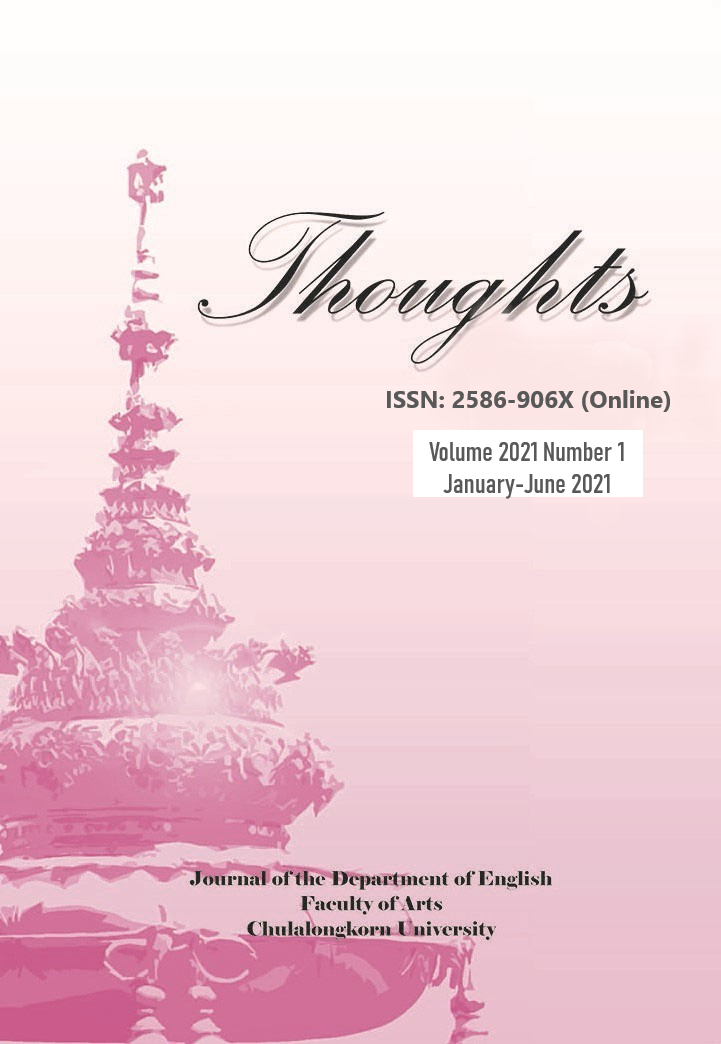Spatiality, Freedom, and Violence in Mohsin Hamid’s Exit West
DOI:
https://doi.org/10.58837/CHULA.THTS.2021.1.1Keywords:
Exit West, Mohsin Hamid, space, freedom, violence, globalisation, liberty, refugee, immigrantAbstract
This paper discusses the relationship between space, freedom, and violence as demonstrated in the novel Exit West by Mohsin Hamid (2017) through the journey of two refugees, Nadia and Saeed. While the novel is closely examined, theoretical ideas regarding space and power from critics such as Michel De Certeau and Michel Foucault are employed, as well as theoretical concepts of violence by Johan Galtung. The essay questions the power of space to liberate human beings as a result of increasingly globalised and technologised world. It argues that space presents contradiction as it is a platform for movement and freedom to be exercised while at the same time becoming a form of confinement and allowing violence to operate. The paper also considers the way memories and ideologies interact with space and influence the actions of those who occupy it.
References
CNN Editorial Research. (2020, October 19). Trayvon Martin Shooting Fast Facts. CNN. https://edition.cnn.com/2013/06/05/us/trayvon-martin-shooting-fast-facts/index.html
De Certeau, M. (1984). The practice of everyday life (S. Rendall, Trans.). University of California Press.
Foucault, M. (2010). The Foucault reader (P. Rabinow, Ed.). Vintage Books.
Galtung, J. (1990). Cultural violence. Journal of Peace Research, 27(3), 291-305. https://doi.org/10.1177/0022343390027003005
Hamid, M. (2017). Exit west. Hamish Hamilton.
Said, E. (2004). Memory, inequality, and power: Palestine and the Universality of Human Rights. Alif: Journal of Comparative Poetics, (24), 15-33.
Van der Kolk, B. A., & Van der Hart, O. (1995). The intrusive past: The flexibility of memory and the engraving of trauma. In C. Caruth (Ed.), Trauma: Explorations in memory (pp. 158-182). The John Hopkins University Press.
Wood, J. C. (2007). Locating violence: The spatial production and construction of physical aggression. In K. D. Watson (Ed.), Assaulting the past: Violence and civilization in historical context (pp. 20-37). Cambridge Scholars Publishing.
Downloads
Published
Issue
Section
License
Copyright (c) 2021 Thoughts

This work is licensed under a Creative Commons Attribution-NonCommercial-NoDerivatives 4.0 International License.
Copyright by the Faculty of Arts, Chulalongkorn University.
Photocopying is allowed for internal, non-commercial use only. Photocopying for other uses or for purposes other than indicated must be permitted in writing from the Faculty of Arts, Chulalongkorn University.
All views or conclusion are those of the authors of the articles and not necessarily those of the publisher or the editorial staff.


